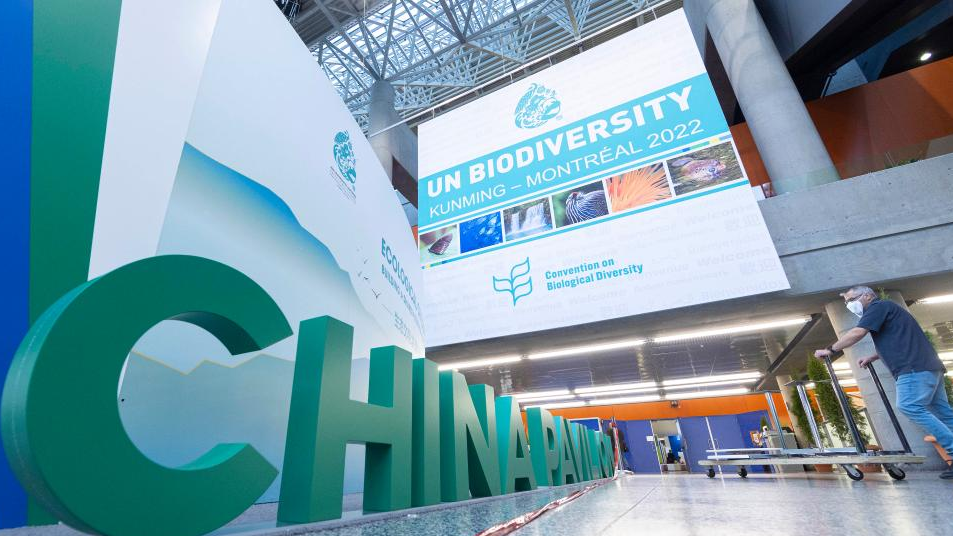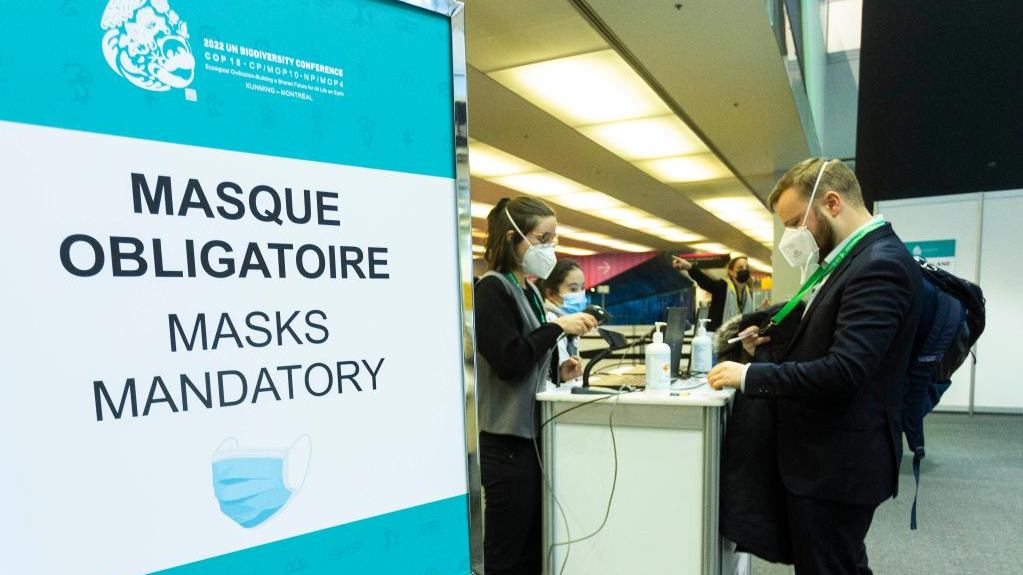
A worker pushes a cart past the China Pavilion of the second part of the 15th meeting of the Conference of the Parties (COP15) to the UN Convention on Biological Diversity (CBD) in Montreal, Canada, December 6, 2022. /Xinhua
A worker pushes a cart past the China Pavilion of the second part of the 15th meeting of the Conference of the Parties (COP15) to the UN Convention on Biological Diversity (CBD) in Montreal, Canada, December 6, 2022. /Xinhua
Editor's note: Alexander Ayertey Odonkor is an economic consultant, chartered financial analyst and chartered economist with an in-depth understanding of the economic landscape of countries in Asia and Africa. The article reflects the author's opinions and not necessarily the views of CGTN.
The 15th meeting of the Conference of the Parties (COP15) to the UN Convention on Biological Diversity (CBD), which has been delayed for over two years due to the COVID-19 pandemic, finally commenced on December 7 in Montreal, Canada. From December 7-19, a host of scientists, activists and government officials from around the globe are expected to agree on a new set of goals for nature over the next decade, via the Convention on Biological Diversity post-2020 framework process.
The framework sets out an ambitious plan to implement broad-based action, aimed at bringing about the needed transformation in society's relationship with biodiversity, a stepping stone towards the 2050 shared vision of living in harmony with nature. By providing a strategic vision and global roadmap for the protection, restoration, conservation and sustainable management of biodiversity and ecosystems for the next decade, the Convention on Biological Diversity post-2020 framework is crucial to the existence of the variety of living species on Earth, now and into the future.
Known to support all life and maintain balance on the planet, biodiversity, which refers to the variety of living species on Earth, including humans, animals, plants, as well as microorganisms, such as fungi and bacteria, provides life-supporting ecosystem services, which includes the provision of food and medicine, fresh water and clean air. Concurrently, biodiversity provides largely invisible services such as nutrient cycling, pollination, water filtration and flood protection – all of which are so vital to food and water security – these indispensable functions are crucial to sustainable development.
In other words, nature underpins human well-being and all economic activities – a report (2021) prepared by the Organization for Economic Co-operation and Development (OECD) for the G7 Presidency of the United Kingdom, shows that about $44 trillion of economic value generation – representing, more than 50 percent of the global gross domestic product (GDP) – is moderately or highly dependent on nature.
Nonetheless, human activity, mainly land-use changes (primarily for large-scale food production and urban sprawl) and overexploitation is destroying natural capital at an unprecedented rate, posing considerable yet often overlooked risks to not only the global economy, but to the health and well-being of current and future generations.
Consistently, the world has produced physical and human capital, largely at the expense of its most important asset, which is, natural capital – from 1992 to 2014, the accounting value of produced capital per head doubled and human capital per head increased by 13 percent, but, the value of natural capital stocks per head dropped by 40 percent, as a result of unsustainable rates of natural resource extraction, pollution and environmental degradation.
As the world confronts unparalleled and accelerating rate of biodiversity loss that undermines the ecosystem services upon which humanity depends, in fact, the global leadership, spearheaded by the COP15 is at the crossroads – populations of vertebrates declined on average by 69 percent, since 1970, and 25 percent of the world's remaining species are threatened with extinction as vast areas of marine, terrestrial and aquatic ecosystems have been destroyed or degraded – with this gloomy picture, how can COP15 halt and reverse the trend? Especially, when none of the 20 Aichi Biodiversity targets set out in 2010 at the COP10 in Nagoya, Japan was met by 2020.

A participant registers for the second part of the 15th meeting of the COP15 to the UN CBD in Montreal, Canada, December 6, 2022. /Xinhua
A participant registers for the second part of the 15th meeting of the COP15 to the UN CBD in Montreal, Canada, December 6, 2022. /Xinhua
To be candid, the panacea to global biodiversity loss does not rest solely on the shoulders of few countries, neither is it characterized by singularly, tackling peculiar challenges across certain fronts. It requires bold, interdependent and scaled up global, regional and national actions to transform existing social, economic and financial models, that have failed to address biodiversity loss. If carried out, this integrated approach could ensure to protect, restore, conserve and ensure global sustainable management of biodiversity.
While the task to halt and reverse the current global biodiversity loss and pursue sustainable management of biodiversity seems daunting, it is achievable. Some countries, which include China, the chair of COP15 has made outstanding progress in conserving biodiversity and ecosystems in recent years – setting the pace for countries to emulate.
At the 14th Meeting of the Conference of the Contracting Parties (COP14) to the Ramsar Convention on Wetlands, which ended on November 13, China became the only country with the highest number of international wetland cities (13) out of the global total of (43) after seven Chinese cities received the prestigious certificate for "Wetland City Accreditation" – a recognition that encourages cities close to, and dependent on wetlands especially designated Ramsar Wetlands of international importance – to enhance the conservation and wise use of wetland resources for sustainable development.
As the chair of COP15, the country's recent gains, in restoring, conserving and protecting biodiversity and promoting healthy ecosystems within a short duration, instils confidence in all the parties, a key requirement as the world undertakes a herculean task.
Considering the impact of biodiversity loss, the solutions reached at COP15 would address all pertinent issues, including increasing financing for biodiversity from both private and public sources, especially in poor countries, ensuring that wealthy nations scale up efforts to support developing countries, and could strengthen efforts dedicated to halt and reverse biodiversity loss at the national, regional and global levels.
(If you want to contribute and have specific expertise, please contact us at opinions@cgtn.com. Follow @thouse_opinions on Twitter to discover the latest commentaries in the CGTN Opinion Section.)